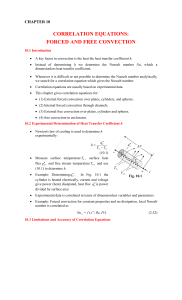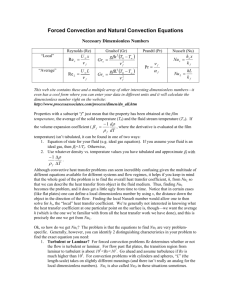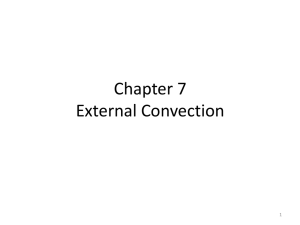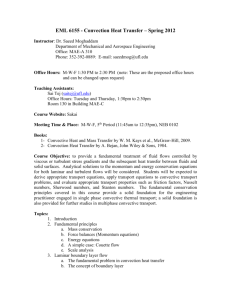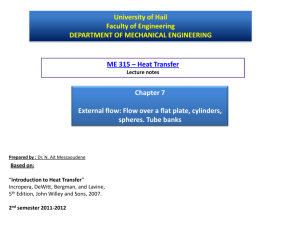CORRELATION EQUATIONS: FORCED AND FREE CONVECTION CHAPTER 10
advertisement
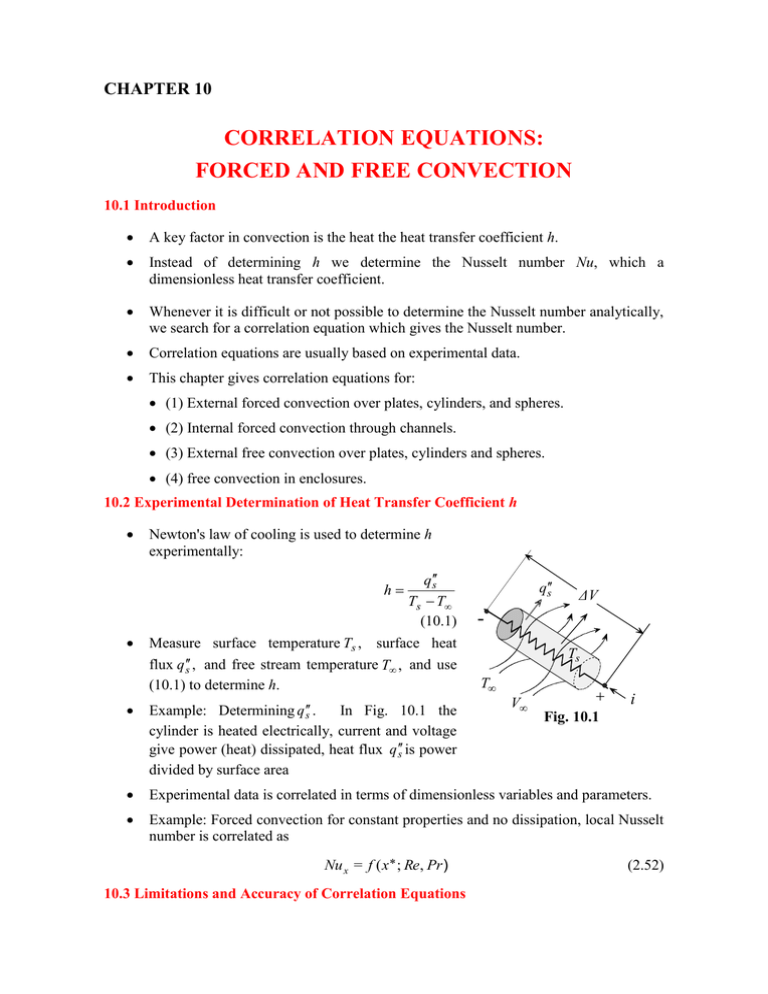
CHAPTER 10 CORRELATION EQUATIONS: FORCED AND FREE CONVECTION 10.1 Introduction A key factor in convection is the heat the heat transfer coefficient h. Instead of determining h we determine the Nusselt number Nu, which a dimensionless heat transfer coefficient. Whenever it is difficult or not possible to determine the Nusselt number analytically, we search for a correlation equation which gives the Nusselt number. Correlation equations are usually based on experimental data. This chapter gives correlation equations for: (1) External forced convection over plates, cylinders, and spheres. (2) Internal forced convection through channels. (3) External free convection over plates, cylinders and spheres. (4) free convection in enclosures. 10.2 Experimental Determination of Heat Transfer Coefficient h Newton's law of cooling is used to determine h experimentally: q s Ts T (10.1) Measure surface temperature Ts , surface heat flux q s , and free stream temperature T , and use (10.1) to determine h. qs h ΔV Ts T V Fig. 10.1 i Example: Determining q s . In Fig. 10.1 the cylinder is heated electrically, current and voltage give power (heat) dissipated, heat flux q s is power divided by surface area Experimental data is correlated in terms of dimensionless variables and parameters. Example: Forced convection for constant properties and no dissipation, local Nusselt number is correlated as Nu x = f ( x * ; Re, Pr ) 10.3 Limitations and Accuracy of Correlation Equations (2.52) 2 All correlation equations have LIMITATIONS. They MUST be carefully noted. Examples of limitations: Geometry: An equation for each configuration. Range of parameters, such as the Reynolds, Prandtl and Grashof numbers, for which a correlation equation is valid, are determined by the availability of data and/or the extent to which an equation correlates the data. 10.4 Procedure for Selecting and Applying Correlation Equations There are many, many correlation equations. Each is for a specific application and is valid under specified conditions. Presenting all correlation equations and discussing their applications and limitations is not the most effective and efficient approach to studying and learning the material. Instead, we will describe a systematic procedure for searching, identifying and selecting correlation equations. Some of the common applications will be presented as examples. Selecting correlation equations for applications not discussed in this chapter follow the same procedure described below. (1) Identify the geometry under consideration. Is it flow over a flat plate, over a cylinder, through a tube, or through a channel? (2) Identify the classification of the heat transfer process. Is it forced convection, free convection, external flow, internal flow, entrance region, fully developed region, boiling, condensation, micro-gravity? (3) Determine if the objective is finding the local heat transfer coefficient (local Nusselt number) or average heat transfer coefficient (average Nusselt number). (4) Check the Reynolds number in forced convection. Is the flow laminar, turbulent or mixed? (5) Identify surface boundary condition. Is it uniform temperature or uniform flux? (6) Examine the limitations on the correlation equation to be used. Does your problem satisfy the stated conditions? (7) Establish the temperature at which properties are to be determined. For external flow properties are usually determined at the film temperature T f T f (Ts T ) / 2 (10.2) and for internal flow at the mean temperature Tm . However, there are exceptions that should be noted. (8) Use a consistent set of units in carrying out computations. (9) Compare calculated values of h with those listed in Table 1.1. Large deviations from the range of h in Table 1.1 may mean that an error has been made. 3 10.5 External Forced Convection Correlations 10.5.1 Uniform Flow over a Flat Plate: Transition to Turbulent Flow Boundary layer flow over a semi-infinite flat plate. Mixed flow: laminar and turbulent. Transition or critical Reynolds number Re xt : Re xt V xt 5 105 (10.3) V , T xt (1) Plate at Uniform Surface Temperature. x turbulent transition laminar The local heat transfer coefficient is determined from the local Nusselt number. Fig.10.2 8.2 Fig. In the turbulent region, x xt Nu x Valid for: hx 0.0296 ( Re x ) 4 / 5 ( Pr )1 / 3 k (10.4a) flat plate, constant Ts 5105 Rex 107 0.6 Pr 60 properties at Tf Average heat transfer coefficient for mixed flow: consider both laminar and turbulent: h (10.4b) 1 L L h( x)dx 0 1 L xt 0 L hL ( x)dx ht ( x)dx xt (10.5) Use (4.72) for hL (x) and (10.4a) for ht (x) , integrate h k 4/5 0.664 ( Rext )1 / 2 0.037 ( Re L ) 4 / 5 ( Re xt ) L ( Pr) 1/ 3 (10.7a) Limitations: see limitations on the respective correlations for the Nusselt numbers. Expressed in terms of the average Nusselt number NuL : Nu L hL 0.664 ( Re xt )1 / 2 0.037 ( Re L ) 4 / 5 ( Re xt ) 4 / 5 k (Pr) 1/ 3 (10.7b) (2) Plate at Uniform Surface Temperature with an Insulated Leading Section. Turbulent flow Nu x 4/5 1/3 hx 0.0296( Re x ) ( Pr ) 1/ 9 k 1 ( xo /x ) 9 / 10 t V (10.8) T insulation xt xo Ts Fig. 10.3 x 4 Limitations: see (10.4b) and review limitations on (4.72) (3) Plate with Uniform Surface Flux. Nu x hx 0.030( Re x ) 4/5 Pr 1 / 3 k Properties T f (Ts T ) / 2, where T s is the average surface temperature. 10.5.2 External Flow Normal to a Cylinder (10.9) T V Average Nusselt number Fig. 10.5 hD 0.62 Re1D/ 2 Pr1 / 3 NuD 0.3 1/ 4 k 0.4 2 / 3 1 Pr 5/8 Re D 1 282,000 4/5 (10.10a) Valid for: flo w n o rm a ltoc y lin d e r Pe Re Pr 0 .2 D p ro p e rtie sa tT f (10.10b) For Pe < 0.2, use N uD hD 1 k 0.8237 0.5 ln Pe (10.11a) Valid for: flo w n o rm a ltoc y lin d e r Pe Re Pr 0 .2 D p ro p e rtie sa tT f (10.11b) The above gives examples of correlation equations and their limitations. Correlation equations for other configurations will be listed without details. Limitations and conditions on their use should be noted. 10.5.3 External Flow over a Sphere 10.6 Internal Forced Convection Correlations 5 10.6.1 Entrance Region: Laminar Flow through Tubes at Uniform Surface Temperature (1) Fully Developed Velocity, Developing Temperature: Laminar Flow. (2) Developing Velocity and Temperature: Laminar Flow. this case is given by [5, 7] 10.6.2 Fully Developed Velocity and Temperature in Tubes: Turbulent Flow (1) The Colburn Equation (2) The Gnielinski Equation 10.6.3 Non-circular Channels: Turbulent Flow 10.7 Free Convection Correlations 10.7.1 External Free Convection Correlations (1) Vertical Plate: Laminar Flow, Uniform Surface Temperature. (2) Vertical Plates: Laminar and Turbulent, Uniform Surface Temperature. (3) Vertical Plates: Laminar Flow, Uniform Surface Heat Flux. (4) Inclined Plates: Laminar Flow, Uniform Surface Temperature. (i) Heated upper surface or cooled lower surface (ii) Heated lower surface or cooled upper surface (6) Vertical Cylinders. (7) Horizontal Cylinders. (8) Spheres. 10.7.2 Free Convection in Enclosures (1) Vertical Rectangular Enclosures. (2) Horizontal Rectangular Enclosures. (3) Inclined Rectangular Enclosures. 10.8 Other Correlations Keep in mind that this chapter presents correlation equations for very limited processes and configurations. There are many other correlation equations for topics such as: Condensation Boiling High speed flow Jet impingement Dissipation Liquid metals Heat transfer enhancements Finned geometries Irregular geometries Micro-gravity Non-Newtonian fluids Etc. Consult textbooks, handbooks and journals.
